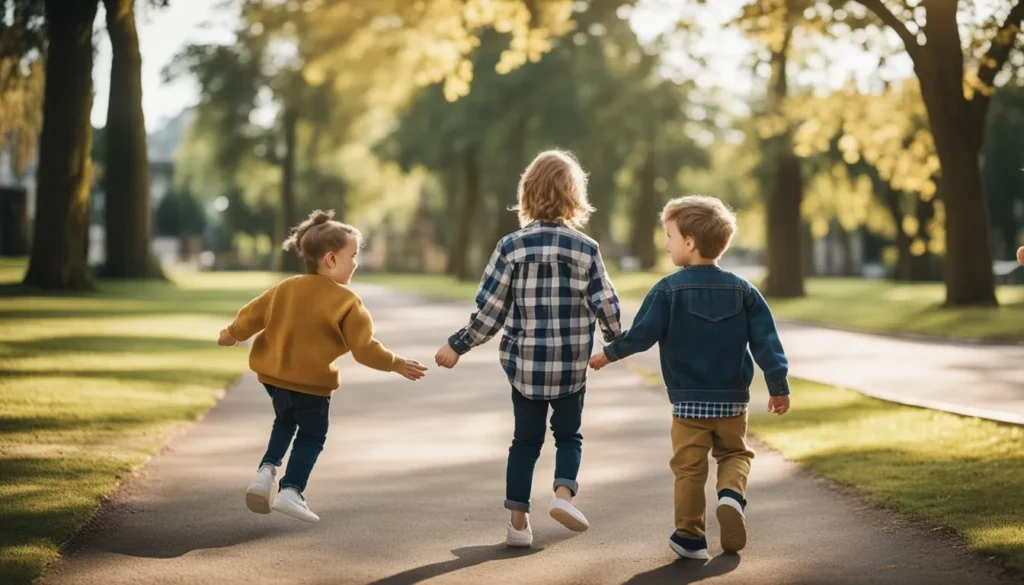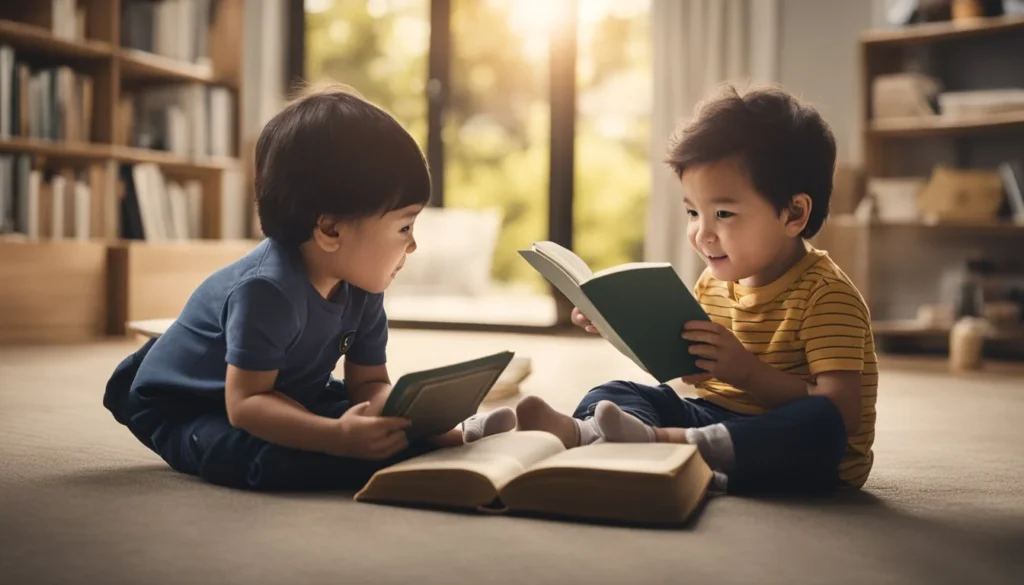Short Answer: Studies indicate that a sibling age difference of 18 to 24 months could potentially lead to the most favourable health outcomes for both the mother and the child. However, this is not a one-size-fits-all answer. Factors such as the family’s financial stability, the parents’ personal preferences, and the mother’s health condition also play a significant role. These are broad guidelines and may not apply to every family. The final decision should be based on what is most suitable for the family unit.
Sibling age gaps can be a topic of great debate among parents, with many wondering what the best age gap is between siblings. While there is no one-size-fits-all answer, there are several factors to consider when deciding on the ideal age gap between children.

Understanding Sibling Age Gaps is the first step in deciding what works best for your family. According to a study cited on Healthline, the ideal time between giving birth and getting pregnant again is 18 months, with a range of 12 to 24 months. However, many experts still adhere to the traditional recommendation of waiting at least two to three years before having another child.
Pros and Cons of Various Age Gaps should be considered when making your decision. Having children close in age can mean they have a built-in playmate, but it can also mean more work for parents in terms of childcare and attention. On the other hand, having children further apart in age can mean less competition for attention and resources, but it can also mean less of a built-in playmate dynamic. Parental Readiness and Family Planning also play a major role in determining the ideal age gap between siblings.
Key Takeaways
- There is no one-size-fits-all answer to the question of the best age gap between siblings.
- Pros and cons should be weighed when deciding on the ideal age gap between children.
- Parental readiness and family planning are important factors in determining the ideal age gap between siblings.

Understanding Sibling Age Gaps
When it comes to having children, many parents wonder what the best age gap between siblings is. While there is no one-size-fits-all answer, there are some important factors to consider when deciding on the age gap between siblings.
Psychological Impacts
Sibling age gaps can have a significant impact on the psychological well-being of children. According to a study published in the Journal of Marriage and Family, larger age gaps between siblings can result in less conflict and rivalry, while smaller age gaps can lead to a closer sibling relationship.
It’s important to note that the age gap between siblings is just one of many factors that can impact sibling relationships. Other factors, such as personality, parenting style, and family dynamics, can also play a role.
Developmental Considerations
Another important factor to consider when deciding on the age gap between siblings is developmental considerations. According to experts, a gap of 18-24 months between pregnancies is optimal to reduce the risk of medical complications and parental stress.
On the other hand, larger age gaps can have benefits as well. Siblings who are further apart in age may have greater relatability and shared interests, which can lead to a closer bond. Additionally, older siblings may be able to help care for younger siblings, which can help them develop important life skills and responsibilities.
Ultimately, the decision of what age gap is best between siblings will depend on a variety of factors, including the parents’ preferences, family dynamics, and individual child needs.
Pros and Cons of Various Age Gaps

When it comes to deciding on the age gap between siblings, there is no one-size-fits-all answer. The ideal age gap depends on various factors such as family dynamics, financial situation, and personal preferences. In this section, we will discuss the pros and cons of smaller and larger age gaps between siblings.
Smaller Age Gaps
A smaller age gap between siblings, usually less than two years, has its advantages and disadvantages. Here are some pros and cons of smaller age gaps:
Pros
- Close Relationship: Siblings with smaller age gaps tend to have a closer relationship as they grow up together and share similar interests and experiences.
- Convenient: Parents with smaller age gaps can reuse baby gear and clothes, as they are still in good condition. They can also save on childcare costs as the older sibling may be able to help out with the younger one.
- Less Gap in Development: Children with smaller age gaps are usually at similar developmental stages, making it easier for parents to manage their needs.
Cons
- Stressful: Having two young children close in age can be stressful for parents, as they may struggle to meet the needs of both children at the same time.
- Sibling Rivalry: Siblings with smaller age gaps may compete for attention and resources, leading to sibling rivalry.
- Financial Burden: Raising two young children at the same time can be financially challenging, as parents may need to pay for childcare, diapers, and other expenses simultaneously.
Larger Age Gaps
A larger age gap between siblings, usually more than three years, also has its advantages and disadvantages. Here are some pros and cons of larger age gaps:
Pros
- More Individual Attention: Parents with larger age gaps can give more individual attention to each child, as they have more time to focus on one child before the next one arrives.
- Less Sibling Rivalry: Siblings with larger age gaps may have less competition for attention and resources, leading to less sibling rivalry.
- Easier to Manage: Parents with larger age gaps may find it easier to manage the needs of each child, as they are at different developmental stages.
Cons
- Less Close Relationship: Siblings with larger age gaps may have a less close relationship, as they may not share as many interests and experiences.
- Less Convenient: Parents with larger age gaps may need to buy new baby gear and clothes, as the old ones may not be in good condition. They may also need to pay for childcare costs for a longer period.
- More Gap in Development: Children with larger age gaps may be at different developmental stages, making it harder for parents to manage their needs.
In conclusion, the ideal age gap between siblings depends on various factors, and there is no one-size-fits-all answer. Parents should consider their family dynamics, financial situation, and personal preferences before deciding on the age gap between their children.
Parental Readiness and Family Planning

Deciding when to have another child is a big decision that requires careful consideration. Factors such as financial stability, parental age and health, and the ideal age gap between siblings all play a role in this decision-making process.
Financial Stability
One of the most important factors to consider when planning for another child is financial stability. Raising a child is expensive, and having another child will only increase the financial burden. Parents should take the time to assess their current financial situation and determine whether they can afford to have another child. This may involve creating a budget, cutting back on expenses, or finding ways to increase their income.
Parental Age and Health
Another important factor to consider is parental age and health. Women who are over the age of 35 may face a higher risk of complications during pregnancy, such as gestational diabetes and preeclampsia. Men who are over the age of 40 may have a higher risk of fathering a child with genetic abnormalities. Parents should also consider their health and well-being when deciding whether to have another child. It’s important to ensure that they are physically and emotionally ready to take on the demands of raising another child.
In conclusion, when it comes to family planning, there is no one-size-fits-all solution. Parents should take the time to carefully consider their unique circumstances and make a decision that is right for them and their families.
Frequently Asked Questions

What are the benefits of a three-year sibling age difference?
A three-year age gap between siblings can have several benefits. For one, it allows the older sibling to have some independence before the younger sibling arrives. It also gives parents enough time to adjust to the demands of raising a child before adding another one to the mix. Additionally, a three-year age gap can help siblings avoid sibling rivalry as they are not too close in age to compete for attention and resources.
How does the sibling age gap impact family dynamics according to research?
Research suggests that sibling age gap can have a significant impact on family dynamics. A study published in the Journal of Marriage and Family found that smaller age gaps (less than two years) were associated with more sibling conflict, while larger age gaps (more than five years) were associated with less sibling conflict. Another study published in the Journal of Family Psychology found that larger age gaps were associated with more positive sibling relationships.
What do personal experiences on forums like Reddit suggest about the ideal sibling age gap?
Personal experiences on forums like Reddit suggest that the ideal sibling age gap varies from family to family. Some parents prefer smaller age gaps as it allows their children to grow up together and form close bonds. Other parents prefer larger age gaps as it allows them to focus on one child at a time before adding another one to the mix. Ultimately, the ideal sibling age gap depends on the individual needs and preferences of each family.
How might a seven-year age difference affect the relationship between siblings?
A seven-year age difference between siblings can have both positive and negative effects on their relationship. On the positive side, it allows the older sibling to take on a mentorship role and help the younger sibling with tasks such as homework and social skills. On the negative side, it can be difficult for siblings with such a large age gap to relate to each other and find common interests. Additionally, the older sibling may feel burdened by the responsibility of caring for their younger sibling.
In what ways does the age gap between a second and third child influence their bond?
The age gap between a second and third child can influence their bond in several ways. A smaller age gap (less than two years) may result in more sibling rivalry as the older child may feel threatened by the arrival of a new sibling. A larger age gap (more than five years) may result in less sibling rivalry but also less of a bond between the siblings as they may have different interests and be at different stages in their lives. Ultimately, the ideal age gap between a second and third child depends on the individual needs and preferences of each family.

